|
|
|||||||||||||||||||||||
 |
This page is specifically designed for seed savers interested in Kenosha Heirloom Tomato variety. The seed to start your own seedlings of this variety is available through SSE (Seed Saver Exchange), current or past Yearbook - look in TOMATO / RED. | ||||||||||||||||||||||
| Learn how I save seed for the heirloom variety Kenosha Paste. | |||||||||||||||||||||||
|
I've missed to create a web page for 2009 - a terrible year for tomato growers as early blight killed the vines by mid September. 2010 turned out fantastic! Possibly my best year. The tomato selection started with the first ripe fruit by August 18th .. and ended with the latest, large fruit I've ever seen this high up the pole - 6 feet high - see picture below for Tomato KP10-5. |
|||||||||||||||||||||||
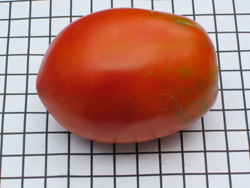 |
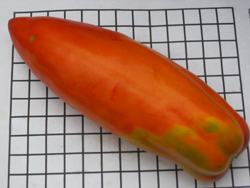 |
||||||||||||||||||||||
|
|
|
||||||||||||||||||||||
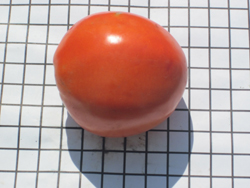 |
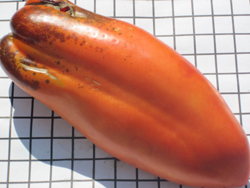 |
||||||||||||||||||||||
|
|
|
||||||||||||||||||||||
|
I've been looking for the more pointy shape because in the past I've noticed less bottom rot on pointy-shaped fruit. In 2010 there was no incident of bottom rot on any rounded fruit [see KP10-1 and KP 10-3 above] and very minimal on the pointy shaped fruit. |
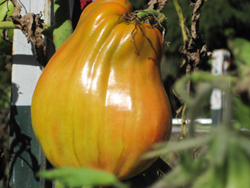 |
||||||||||||||||||||||
|
|
|||||||||||||||||||||||
| About 40% of the vines planted in 2010 showed bottom rot on some fruit (perhaps on 2 tomatoes out of 15 - 20 which I allow per vine). So I assume that I had about 60 tomato with signs of bottom rot out of an estimated harvest of 950, which equals to about 6% - but almost all the fruit affected with signs of bottom rot still made my market stand and were sold. The bottom rot signs were limited to a tiny black spot, less than 1/4" deep - almost invisible to the untrained eye. In the past I had bottom rot through the center of the fruit rendering the tomato uneatable. This year I may have found 3 uneatable fruit due to bottom rot - I lost many more tomato damaged by racoons!
The fruit in the pictures above were selected from vines NOT affected at all with bottom rot, and I also look for NO shoulder cracking. [KP 10-4 has a little cracking] Also, new for 2010, all vines were grown as a "ONE VINE TOMATO" (all side growth was timely pruned) and all top leaders were cut by August 15th to promote larger fruit. If you are interested in growing "one vine tomato" please join us on facebook. Search for "One Vine Tomato" or click here The first four tomatoes were picked in September while tomato KP 10-5 was picked mid October. The picture of tomato KP 10-5 was taken the first week of October - notice the green pole in the back ground - the white marking is the tip of the 6 1/2" tall pole. I've never seen a tomato of this size, so late in the season, and this high on the pole. Also, notice the shape of KP 10-5 ... this is what may develop on "potato leaf" tomato varieties, where the fruit develops into a double fruit. See the grid for the fruit size measuring 5" x 3.5". The "cut" picture shows the double fruit quite clearly. |
|||||||||||||||||||||||
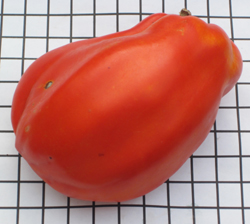 |
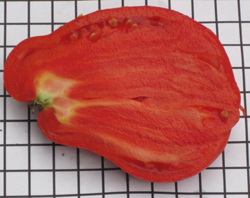 |
||||||||||||||||||||||
|
|
|||||||||||||||||||||||
|
|
|||||||||||||||||||||||
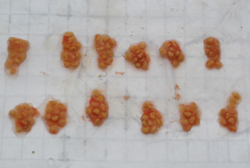 |
|||||||||||||||||||||||
|
Number of seeds
The very limited number of seeds per fruit is also quite interesting. The fruit KP 10-5 is a double fruit - yet I only found about 120 seeds. While in fruit KP 10-4 I only found 25 seeds. |
|||||||||||||||||||||||
| Notice the size of some seeds - some are as large as 1/4" (second group - bottom row).
I place the wet seed on wax paper to dry out and in this picture below the wax paper you can see my standard 1/2" grid - obviously the seed will shrink after drying. When the seed is dry, it is placed in a small plastic bag and left in the freezer for a few weeks. I store my seed in a dry closet and don't open the plastic bag until it is time to start the seed in the spring. Usually I experience a very high (95% plus) germination rate for several years. |
|||||||||||||||||||||||
|
In 2011 I've found fruit on vines started with the seed of tomato KP 10 - 4 with extremely low seed counts. 4 fruit only had 5 - 12 - 18 - 46 seeds. In 2012 I'm planning to grow mostly tomato from this LS seed and monitor how the seed counts will evolve over the years. |
|||||||||||||||||||||||
|
You may have found this page linked to my chronical pages on bottom-rot. If not, on those pages you can review more info on the history of this cultivar and the challanges that I have encountered. Click here to go to those pages |
|||||||||||||||||||||||
|
Two of the five tomatoes selected for seed saving in 2007 produced seed that did not germinate well, therefore I'm not saving seed off those vines. I'm very happy to report "zero" bottom rot on all vines K1 and K5, while K3 produced a few tomatoes with bottom rot ... but very few compared to years ago. Click here to read more ... |
|||||||||||||||||||||||
| Share your seed
Once you are satisfied with the quality of your plants and keep saving seeds for several years, the time comes to start sharing seeds. Become a member of Seed Savers Exchange. www.seedsavers.org/membership By becoming a member ($40 per year membership fee) you can order seed from 700 plus sources. Unfortunately there are only 49 seed savers in Wisconsin and 24 in Illinois ... but only 2 in Kenosha and Racine Counties. We need to change that and have more local gardeners listed in Seed Savers Yearbook to make seed available to other local gardeners. This page lists all cultivars that I save - some are available to all (HAS), most are reserved to "listed" SSE members - click here to review the list of cultivars. Please call Seed Savers, become a "non-listed" member (support this no-profit organization) and eventually join me in offering seed as a listed member. Call (563) 382-5990 |
|||||||||||||||||||||||
|
|
|||||||||||||||||||||||